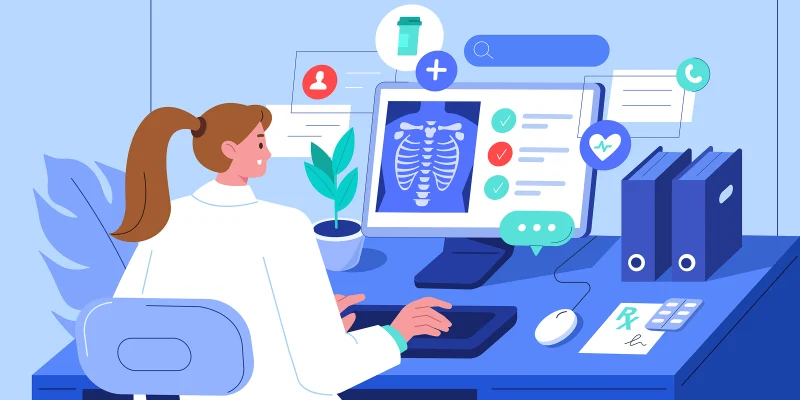When the 988 Suicide and Crisis Lifeline was launched in 2022, my first thought as a psychiatry resident was “finally.” I was excited, perhaps naively, about the prospect that we would soon enter an age of easier access to timely emergent mental health services for people in need.
That excitement was soon tempered by necessary questions, however. How would people become aware of this resource? Would it be adequately staffed? Who would be responding to these calls, and what happens when callers in crisis cannot be de-escalated over the phone? I wanted to be aware of what I was recommending to my patients, and what it meant to call 988. To build a better understanding of the hotline and its limitations, I decided to look further into its recent history and the process of its implementation.
988 in Theory: Greater Accessibility and Inclusion
Having a suicide hotline isn’t a new concept. The National Suicide Prevention Hotline was previously a 10-digit number, which was transitioned into the simpler 3-digit number under the National Suicide Hotline Designation Act of 2020. This act was preceded by legislation that had bipartisan support. It required the creation of a new hotline number that would be less cumbersome and easier to remember, as well as mandated in every state. Though this is a state-led and state-funded initiative under a federal mandate, additional federal funding was provided to help states expand the infrastructure currently in place and to increase staffing by the time 988 went into effect in summer 2022. Additionally, specialized reporting and training for at-risk populations was required by this new law, including “LGBTQ youth, minorities, rural individuals, or other high risk populations.” This requirement represented a step forward in terms of care, and implied greater accessibility and inclusion.
988 in Practice: Concerns About Involuntary Interactions with Law Enforcement and More
Callers have various ways of interacting with 988: through traditional phone call, text, or online at 988lifeline.org. After contacting 988, calls are routed via area code (as compared to geo-routing with 911 calls) and a trained counselor answers, who can help with connecting the caller to resources in the community and utilizing verbal de-escalation techniques. Ideally, this would happen at a local crisis call center, though if the wait is too long, people may get routed to overflow call centers that may be located out of state. Since out of state counselors may be less familiar with local resources, callers may find these conversations less helpful as a result. (Bills, such as the 988 Lifeline Location Act of 2023 in New York, have been introduced in some states to develop geolocation services for 988 that would mitigate this issue.) Additionally, in some states, mobile crisis services are also available, which offer the option for a mental-health specific emergency crisis response in person.
If these interventions are unsuccessful, counselors have the option of activating “involuntary emergency services,” such as 911, for callers “at imminent risk” who “remain unwilling and/or unable to take action to secure their own safety or [for whom] there is already an attempt in progress.” Understandably, as concerns about the involuntary involvement of law enforcement in mental health crises rise, this was a particular point of focus in response to the publicizing of 988. Studies have shown the danger that individuals with mental illness face when interacting with law enforcement during times of crisis. In 2015, a study of all civilian deaths during interactions with the police showed that 23% of the deceased had a mental illness. A report cited by the U.S. Commission on Civil Rights in 2018 stated that on average, “police shot and killed someone who was in mental crisis every 36 hours in the first six months of [2015].” Compounding this is the increased risk of violence that communities of color experience during interactions with law enforcement.
The risk of being brought to the ED involuntarily remains a concern for callers as well. Sometimes, this is a necessary clinical intervention that can allow for intensive treatment and stabilization via hospitalization. Other times, individuals may be waiting for evaluation in the ED for several hours before being discharged if they do not meet criteria for hospitalization, an experience that may negatively affect their view of and relationship to the mental health system.
988 and Patients: A Starting Point, Not an Endpoint
988 is certainly not a perfect answer. Beyond the issues above, there’s lack of access to contend with: Per the most recent data available on the National Alliance on Mental Illness (NAMI) website, only eight states have enacted comprehensive 988 implementation legislation (others have enacted partial legislation, or have legislation pending).
Furthermore, there are plenty of issues that require infrastructure that we just don’t have. Ideally, we would have better staffing for local crisis centers, as well as robust mobile crisis teams to mitigate the need for emergency services at the hands of individuals without adequate training. NAMI has advocated additionally for crisis stabilization options that exist at the juncture of the hospital and outpatient programs to assess whether a hospital evaluation or admission may be warranted, versus a less intensive treatment option. All of these changes require funding, which in turn requires advocacy, as well as time for implementation.
However, the above may be moot points when you consider that at this stage, most Americans (82% as of summer 2023) aren’t even familiar with 988 — and those that are aware are likely to be younger. This makes it imperative to raise awareness of the hotline, even if it’s not a silver bullet. Presenting 988 to our patients with a discussion of risks and benefits, like with any medical recommendation, goes a long way. One statistic that I’ve found helpful when discussing the hotline with my own patients is that according to SAMHSA, only about 2% of 988 calls are routed to 911 for emergency services. It’s a non-zero risk, but a minority of calls nonetheless.
At the same time, if we want these services to look different for our patients in the future, viewing this hotline as a starting point rather than an endpoint is crucial. We are still at a stage where 988 does not have stable funding in most states, and the availability of crisis stabilization services varies by state. The way I see it, recommending the use of 988 to my patients does not mean I stand behind everything it is at present. It means I stand behind the concept of what it could be.
Have your patients inquired about 988? Share in the comments!
Dr. Avneet Soin is a psychiatry resident in New York City. She is interested in consultation liaison psychiatry and advocacy work, and in her free time enjoys reading and exploring the dessert scene in NYC! Dr. Soin is a 2023–2024 Doximity Op-Med Fellow.
Image by: Benja Boonyakitsombat / EyeEm / GettyImages







